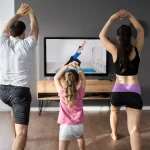With fitness centres reopening their doors once again, group virtual fitness classes are returning with a bang. Prescheduled or on-demand workout sessions include HIIT training, yoga practice as well as more.
They are often led by expert trainers who offer training cues and form corrections, making it an ideal programme for those who are self-conscious about exercising in groups.
Convenience
Virtual exercise is a digitalised version of working out at a gym setting, essentially providing you with an instructor, trainer and workout programme on your device. You can select a prerecorded class whenever you want or live stream one whenever you’re free! It can help keep you involved even when exercising alone, and whether you prefer working out with friends on a regular basis or you just like some basic interaction with others over the internet, all these new and improved tech tools incorporate one or the other of these elements. For instance, many popular existing fitness apps incorporate chat functions for interactivity, and many new online fitness programmes allow for personalised program planning and occasional check-in sessions with one’s online workout buddy. Classes held virtually also offer a great alternative to shy exercisers who feel awkward workout out in front of others, allowing you to work out with a smaller group in which you can take breaks as needed, and even gamifying this experience, turning it from a chore into a fun and competitive activity. One study also showed that exercisers who wore headsets tended to work out for longer periods of time.
Variety
(Virtual classes are available for almost any discipline – HIIT, yoga, cycling, dance, strength training – both live and on-demand as a part of home as well as gym subscriptions.) Les Mills virtual group exercise classes, for example, are led by top instructors on screen – the same trainers who developed the programmes – so consumers know they are in good hands. Gyms can offer classes through streaming apps, in-house kiosks or through a proprietary fitness platform that also serves up on-demand video programming for solitary workouts at different times or in the privacy of home.
Accountability
Trainers, fitness professionals and gym/studio owners can offer more options, convenience and accessibility to exercising and offer more affordable workout plans using the right equipment and a video streaming software application to post real-time live or on-demand workouts. Some sites also allow you to chat live with trainers to develop relationships, find support and stay accountable, and, of course, you can see results via built-in metrics. But virtual training also lacks the social energy and camaraderie that many in-studio classes provide, which can make staying motivated and consistent hard for some exercisers. Still, the data does show that virtual classes can offer fitness results if they’re a part of an overall healthy lifestyle[3].
Flexibility
The freedom to choose when to work out is a key selling point for virtual fitness classes in which the consumer does not have to meet with the instructor at a predetermined time and location for a class. Virtual fitness classes are offered in pre-recorded or live-streamed forms, ready for then consumer in their home on a computer, a smartphone or a television. Fit individuals can now set their own schedule and squeeze in exercise at a time that works best with their hectic lives, and for those who feel they don’t have easy access to doctors or weight-loss programmes, exercising at home can help to provide more confidence. It’s time for fitness professionals to take virtual fitness seriously. With an online component that complements and amplifies what they’re providing directly in-person, they can both maintain existing clients as well as satisfy new ones by continuing to deliver the value they’ve been accustomed to receiving.
Community
Virtual fitness classes, for example, mean that many people create social groups that they need, via the class and online forums or social media groups that can provide accountability and support, raising motivation. For many who prefer smaller group class settings but cannot exercise in crowds, the virtual class option can help develop confidence while receiving direction from home in a private space. Additionally, an instructor who monitors form in a class may be able to ensure that participants avoid injuries. In most cases, virtual programmes offer a variety of exercises and classes, including yoga, cycling, strength, and high-intensity interval training (HIIT), as well as sessions with trainers who can hand out virtual high-fives and emphasise good form. Of course, you won’t get the same muscle-building benefits from the bodyweight hang squat or the moderately challenging floor tricep extension bang that you would from a regular weight rack filled with discs and a Smith machine, but you’ll still see demonstrable results.







 Understanding Skin Types – Normal, Dry, Oily, Combination
Understanding Skin Types – Normal, Dry, Oily, Combination  The Ultimate Skincare Routine for Every Skin Type
The Ultimate Skincare Routine for Every Skin Type  The Essential Guide to Digestive Enzymes Australia: Boost Your Gut Health
The Essential Guide to Digestive Enzymes Australia: Boost Your Gut Health  Latest Breakthroughs in Acne Treatment
Latest Breakthroughs in Acne Treatment  The Rise of Virtual Fitness Classes
The Rise of Virtual Fitness Classes  Fun and Creative Ways to Stay Active Indoors
Fun and Creative Ways to Stay Active Indoors  Linking Oral Health to Overall Wellbeing
Linking Oral Health to Overall Wellbeing  Can You Exercise While Pregnant?
Can You Exercise While Pregnant?  Is Skin Cancer Curable?
Is Skin Cancer Curable?